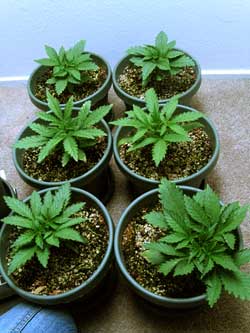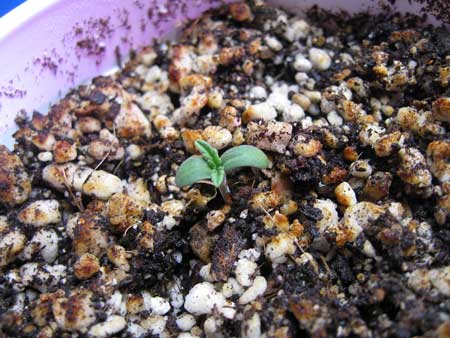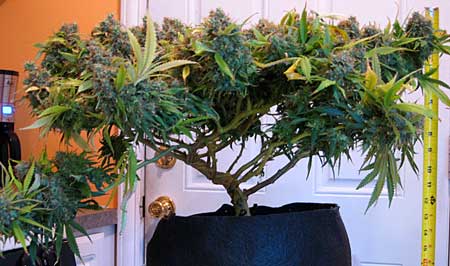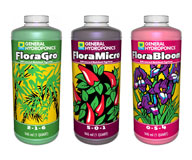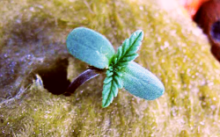You are hereHow to Hydrate Coco Coir Bricks (makes 9-10 gallons) - plus a tutorial on how to grow cannabis in coco coir
How to Hydrate Coco Coir Bricks (makes 9-10 gallons) - plus a tutorial on how to grow cannabis in coco coir
by Nebula Haze
Table of Contents
Coco Coir Rehydration Tutorial - Make an Excellent Coco Coir Mix at Home
How to Grow Cannabis with Coco Coir
$300 Hydro Grow (Coco Coir with CFLs)
Interested in growing cannabis with coco coir? Coco coir is a relatively new growing medium for cannabis that gives the experience of growing in soil, but many of the benefits of growing cannabis in hydro (such as faster growth and bigger harvests).
A lot of cannabis growers have started adding coco coir to their garden, but there isn't a lot of information about exactly how to use coco coir for cannabis. It can be confusing since coco coir usually comes in dehydrated bricks with no instructions.
What is Coco Coir?
Coco coir (coir is pronounced "coy-er") is made of fibrous coconut husks. These husks have proven to create a great growing medium for cannabis. Recently coco coir has started replacing peat moss in popular potting mixes.
Coco coir is a versatile growing medium that has benefits for many different types of growers. Coco coir can be used by itself as a growing medium, or it can be mixed with soil to help fix compaction and loosen the soil. One of the most suitable ways to use coco coir for cannabis (in my opinion) is to mix pure coco coir with about 30% of an airy amendment like perlite, and provide nutrients through the water. This creates an amazing environment for cannabis roots to thrive.
Why Use Coco Coir for Growing Cannabis?
-
Feels Like Growing in Soil - Coco coir is a soilless growing medium which gives the experience of growing in soil. Plants are kept in regular pots, and growers simply water their plants with nutrient water. Coco coir can be treated basically the same as soil for growing cannabis.
-
Great for Plant Roots - Coco coir is effective at holding onto moisture and nutrients for roots, but also has a lighter texture that lets it hold onto more oxygen. This helps prevent over and underwatering. Coco coir tends to promote healthy and fast root development compared to other potting mixes.
-
Good for the Environment - Unlike peat, coco coir is sustainable for the environment. It also doesn't have to be replaced every grow. Instead of breaking down like peat, coco coir is slow to break down and can be used more than once.
-
Does Not Attract Insects - Coco coir does not make a good home for many garden pests that affect soil growers. Cannabis growing in coco coir are much less likely to be attacked by pests or bugs.
-
Get the Benefits of Hydro - Hydro is effective at making plants grow faster because it provides exactly the right amount of nutrients to the roots, in the most easily accessible form. Plant roots don't have to go out and search for nutrients, saving the plant precious energy. But growing directly in water can be complicated. Coco coir gives many of the benefits of hydro with a soil experience. This results in a quicker harvest and bigger yields for you as the grower, without having to manage a water reservoir.
Cons of Growing Cannabis in Coco Coir
-
Coco coir is an inert growing medium with no inherent nutritional value, so growers must provide nutrients and manage pH throughout the grow. However, this is also the case for many soil growers as well. Unless starting with composted super soil, most soil growers end up having to add nutrients and manage pH just like with coco coir.
-
Cannabis plants grown in coco coir tends to need more calcium compared to other growing mediums, so usually a standard "Cal-Mag" supplement is needed to make sure plants get all the calcium they need.
-
Coco coir usually comes in dry bricks, so the bricks have to be re-hydrated before you can grow plants in the coir (explained below, it's actually really easy).
-
There are premade mixes with coco coir, but they tend to be expensive. It's much cheaper to spend the half hour to make your own mix.
Coco coir holds onto a lot of moisture, but also holds onto more air than similar materials, so your plant roots are getting the oxygen they need to thrive. When mixed with perlite, it provides and ideal amount of water and air for cannabis roots. Coco coir drains well so plants are less likely to get overwatered, but it also holds onto nutrients so you use less fertilizer.
Once your plants are in a good coco coir mix, you just add nutrients, water and light to get happy plants.
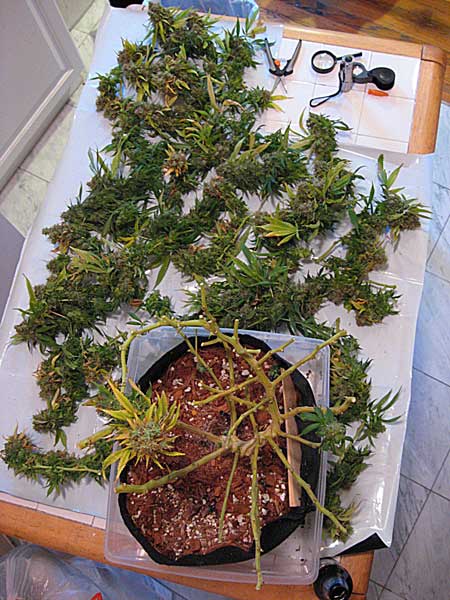
pics by FirstDescent
Although growing cannabis in coco coir is becoming increasingly popular, one of the problems is that there's not enough free information to help new growers know what to do. It's only a few simple steps get your coco coir mix in tip-top shape, and this tutorial will show you exactly how to do it.
Which Nutrients for Coco Coir?
When growing cannabis in coco coir, always use nutrients made for coco coir or hydroponics. Most growers also benefit from adding a "Cal-Mag" supplement, which is a common gardening supplement that provides extra calcium. Learn more about which nutrients you should use for growing cannabis in coco coir.
There are pre-made coco coir mixes, but these are much more expensive than making a mix yourself. A pre-made mix is also heavy like soil because of the water that's been added. This makes a pre-made coco coir mix expensive to ship, and heavy to carry around. But you can get everything dry and just add water at home, so you're not paying a premium for water.
Everything you need to make your coco coir mix can be sent discreetly to your house. You just need some coir bricks and an airy bag of perlite which can be bought at any garden store. With this method, there's no lugging a huge bag of potting mix home, or paying for shipping to have it delivered.
This tutorial will show you how to re-hydrate coco coir bricks and mix with perlite to create a rich, cannabis-friendly potting mix. I will also share some hints about growing cannabis in coco coir and how to take care of your plants for the best results.
If you follow these instructions, you will end up with 9-10 gallons of potting mix. I used this to fill four 2-gallon pots plus six solo cups, which is a perfect amount of soil for me to grow 4 plants.
Ready to start your coco coir tutorial? Your garden will thank you for it!
Coco Coir Rehydration Tutorial: What You Need
Makes about 10 gallons of potting mix
2 coco coir bricks (650g each)
For this tutorial I used two bricks of "Nature's Footprint 650g Coconut Coir Brick, Medium." However, any similarly sized bricks from a reputable company will also work.
8-quart bag of perlite
I used "Black Gold" perlite, but any 8-quart bag of perlite will work. Perlite can often be found in garden stores or the garden section of places like Home Depot and Lowes. I normally advise against all things Miracle-Gro, but their 8-quart bag of perlite is okay for this tutorial if you can't find anything else. But remember, never use Miracle-Gro soil or their standard nutrient formula! But their perlite is okay. Any 8-quart bag or perlite will work for this tutorial. There's not much you can do to mess up perlite.
10-gallon fabric container & 5-gallon bucket
I use a 10-gallon fabric container from Mad Farmer (basically a Smart Pot by a different company) because it’s sturdy, has handles and will stand up on its own after adding coco coir. You could use a 10-gallon Smart Pot, two pillow cases stacked inside each other, or any other fabric container that lets water through and is tough enough to hold 5 gallons of soil.
Here’s the 10-gallon Mad Farmer fabric pot & 5-gallon bucket in a bathtub
Note: You also need access to water and a drain for this coco coir tutorial.
Before You Get Started
(optional)
Run your finger nails over a bar of soap. This adds a layer of soap under your finger nails, which will prevent coco coir from getting stuck under your nails. Save yourself the time it takes to clean your nails after you're all done!
See What You're Making
Makes about 10 gallons of potting mix
This will make about 10 gallons of potting mix, just enough potting mix for...
-
2 x 5-gallon containers
-
OR 3 x 3-gallon containers plus a little extra
-
OR 4 x 2-gallon containers plus extra
-
OR any setup that uses about 10 gallons of potting mix
Note: I hydrate the two bricks one at a time in the 5-gallon bucket because the 5-gallon buckets are easier for mixing in perlite, and the whole process goes by in less than a half hour anyway even if you do bricks one at a time. If you wanted, you could hydrate both bricks at once in a 10 gallon container, but that's too heavy for me to work with :)
How to Rehydrate Coco Coir & Mix in Perlite
1.) Gather all materials and place everything near your tub (or wherever you’re going to rehydrate to coco coir bricks)
2.) Line inside of 5-gallon bucket with fabric container.
The inside of the bucket should be lined all the way to the top, and you need to have enough extra to be able to easily grab the top so you can lift it up later.
3.) Put the first coco brick inside the liner
4.) Fill the bucket halfway with water.
Optimally, you can add a Cal-Mag supplement and pH this water to 6.0 before soaking. This can help make sure your coco coir has extra Calcium and also help it get into the right pH range right from the beginning.
Honestly though I often use water right out the tap. You'll be adding Cal-Mag and setting the pH later, but the "best" way is to start supplementing your coco coir now, and it definitely may save you time and trouble later.
You’ll see the brick almost instantly starts getting soft once it makes contact with the water.
5.) Wait 8-10 minutes or until the coco coir gets fully hydrated.
If you stick your hand in and there’s no more hard parts left, then you’ve waited long enough. The coco coir should feel soft all the way through the bucket. You can mix the slurry around with your hands to get it to break up faster if you're in a hurry.
Some growers let it soak longer, especially if they're using pH'ed water that's been supplemented with a Cal-Mag supplement, giving the coco more time to "take in" the good stuff. But I usually wait about 10 minutes and go to the next step.
6.) Pull liner up and out, letting water drain.
First let the majority of the extra water drain out into the bucket, then place the liner in the tub or on the ground so it can continue to let water drain out slowly.
7.) Pour half the 8-quart bag of perlite on top of your coco coir
8.) Mix in perlite with hands
Make sure to mix everything thoroughly, and check around the sides too, where you'll often find pockets of perlite or straight coco coir. It's really easy and quick. Just stick your hands in and mix everything together until it looks even all the way through :)
This moving gif should hopefully give you an idea.

After mixing, your potting mix will feel light and kind of soggy. You should end up with something that looks like this.
9.) Fill your containers with potting mix
One batch will fill just under than 3 x 2-gallon containers or 2 x 3-gallon containers. It should fill a 5-gallon container.
Don’t worry if the mix feels wet, it will dry in the fabric pots once you have a fan blowing over them in your grow tent.
10.) Repeat steps for second brick of coco coir & remaining half of perlite bag
Now you fill the rest of your fabric containers and possibly solo cups for seedlings.
Note: If you do use solo cups, make sure to cut holes into the bottom so that water can drain out after you've watered your plants. Always test to make sure water runs through cup freely. If you have a hard time filling up an empty solo cup with water because it's running out the bottom, you have added the right amount of drainage.

How to Grow Cannabis in Coco Coir
Recap: Do you have everything you need to make your coco coir mix? You'll need the following items to complete the tutorial above.
-
2 x 650g coco coir bricks <-- Available on Amazon
-
8-quart bag of perlite <-- Available on Amazon
-
10-gallon fabric pot <-- Available on Amazon
-
5-gallon bucket <-- Available locally (Home Depot, Lowes, etc)
The above tutorial should leave you with about 10 gallons of potting mix.
Now that you've got your mix ready, it's time to start growing!
This isn't the only way to grow cannabis in coco coir, but this is what I do and it works great. It directly follows the tutorial above for rehydrating coco coir and creating a coir-perlite potting mix.
Which Nutrients for Coco Coir?
Any quality cannabis nutrients made for hydroponics will work well as long as you also use a Cal-Mag supplement.
Learn about different cannabis nutrients: http://www.growweedeasy.com/nutrients
I personally like the General Hydroponics Flora trio plus Calimagic (a Cal-Mag supplement) for growing in coco coir.
This is a tried and tested nutrient system for any type of hydroponic growing including coco coir. You can actually follow their nutrient schedule listed on the included nutrient schedule; it's formulated for plants like cannabis.
Here is the nutrient schedule I'm using right now (pdf)
Note: After adding nutrients (or even if you're giving just plain water), always pH your water to 5.5-6.5 before giving it to your plants. This is important!
Like nearly all cannabis nutrients, the included schedule is aggressive and can burn your plants if given with every watering. No matter what nutrient system you're using with your coco coir, I recommend giving plain water every other watering to prevent nutrient buildup.
Here is the coco coir nutrient schedule I'm using right now (pdf)
Whenever using liquid nutrients, you will need a way to test pH so your plant roots are able to easily absorb all the nutrients they need. I use a simple General Hydroponics pH test kit. Learn more about managing pH here: http://www.growweedeasy.com/ph
How much Cal-Mag should I use for coco coir?
Give Cal-Mag at full strength alongside your nutrients for at least two weeks at the beginning of your grow. You may also add Cal-Mag with your other other nutrients if needed throughout the grow, though you may want to give it at lower doses.
-
Plant Containers - I like fabric pots
-
Solo cups (optional)
-
Rapid Rooters (optional)
If you followed the above tutorial to make your own coco mix, you'll have about 10 gallons of potting mix. This can be used to fill 2 x 5 gallon pots, 3 x 3 gallon pots, or 5 x 2-gallon containers.
I recommend larger containers for larger plants and to water less often. I recommend smaller containers for smaller plants, and when the grower is willing to water more often.
Step-by-Step Grow Cannabis Coco Coir Tutorial
1.) Germinate seeds in fresh Rapid Rooters on top of the moist but not soaking coco coir in your solo cups. Some growers will plant their seeds directly in the coco coir, and that works well, too. You can also place the Rapid Rooters in a tray, making sure there's a very shallow pool of water at the bottom to keep them moist. Fresh Rapid Rooters give some of the best germination rates, but of course there's other ways to start your plants. Learn about other ways to germinate cannabis seeds here: http://www.growweedeasy.com/germinate
2.) After seedling grows first set of "real" (serrated) leaves, water with nutrients at normal seedling strength, and add a regular dose of Cal-Mag (Calimagic). Keep giving water until you get about 20% runoff out the bottom of the solo cup. The first set of leaves are round, but the second set are serrated and pointy. Once you see those leaves, it's time to water your seedling with nutrients.
3.) Maintain seedlings. Some growers will put their Rapid Rooters in solo cups, while others put their seedlings directly in their final container. Either way, your job is the same. Make sure your seedlings get plenty of light while making sure that it's never too hot for your seedlings. Place your hands where your seedlings are and wait 10 seconds, if it's too hot for you, it's too hot for your plants.
-
Continue to water plants at full seedling strength of the included nutrient schedule for the General Hydroponics Flora Series plus Cal-Mag.
-
When watering, keep giving water until about 10-30% extra runs out the bottom. Then don't water again until the top inch or so starts feeling dry to the touch. If you notice water is not draining out, you need to fix that right away. Water should be able to drain freely soon after you start watering.
-
Wait until the seedling has grown 3 sets of leaves...
3b.) If you started in solo cups, you should transplant to bigger containers once the seedlings have grown about 3 sets of leaves. Once your seedling has grown 3 sets of leaves, it's time to transplant to a bigger container!
Dig a small hole in your coco coir containers so there's room for the new seedlings. Take a butter knife and carefully slide it all around the edges of each solo cup, then carefully transplant your seedling into your bigger coco coir containers.
4.) Maintain vegetative plants until they are half the final desired size.
Cannabis nutrients tend to have schedules that give too high levels of nutrients for proper growth. If you're using the custom nutrient schedule I created for you above, you can simply follow the instructions. But if you're using a different nutrient system, I encourage you to start providing all nutrients in the water at half strength.
Continue to water plants with nutrients with 10-30% extra runoff. Continue to always adjust pH water to 5.5-6.5 before giving it to plants.
-
If desired, this stage is when you start plant training (I recommend waiting a few days after the transplant to make sure plant isn't stressed before starting any training).
Note: If you are growing auto-flowering plants from seed, it's recommended you don't use any plant training techniques besides LST. -
If you notice the lower leaves are starting to yellow, and the yellowing seems to be climbing up the plant from the bottom, it probably means you have a nitrogen deficiency. Look at the nitrogen deficiency page to make sure. If you have a nitrogen deficiency at this stage, it means your plants need higher levels of nutrients. If so, increase your nutrient levels slowly, watching closely for signs of nutrient burn (which means too high levels of nutrients). Remember that yellow leaves will likely not turn green again, so don't look to old leaves for recovery. What you're looking for is making sure the problem isn't still spreading to different leaves. It's also likely that any improvement may take a few days after you provide increased nutrient levels. So don't keep upping your dose until you've given your plant a few days to a week at the new level!
-
If you have any other problems besides a nitrogen deficiency, consult this page: http://www.growweedeasy.com/7-step-cure
-
Once plants are half the desired size, switch to the flowering stage (if you have auto-flowering plants, they will automatically switch to flowering after about 3 weeks).
This stage lasts until your plant is about half the size you want it to be in the end. After your plant has grown half the desired size, it's time for the next step.
5.) Switch to the flowering stage. With regular plants, you do this by changing your light schedule to 12-12 (12 hours of light, plus 12 hours of uninterrupted darkness). With auto-flowering strains the switch to the flowering stage happens without you needing to do anything. Learn more about cannabis life stages and switching the flowering stage.
6.) Maintain flowering plants until they are ready to harvest. Care is basically the same as before, except during the flowering stage it becomes more important to control temperature and humidity than ever. Cannabis plants are much more finicky in the flowering stage, and it's easy to trigger problems if you aren't controlling your environment. Watch over plants closely, and make every effort to expose all bud sites to light and a breeze. You can still train plants by gently bending too-tall colas, but avoid any major training once the plant has started making buds.
7.) Harvest buds when ready. This tutorial will explain everything you need to know about when to harvest your plants: http://www.growweedeasy.com/harvest
Happy Growing!
Jump to...
10-Step Quick Start Guide to Growing Cannabis
Which Grow Light Should You Get?

